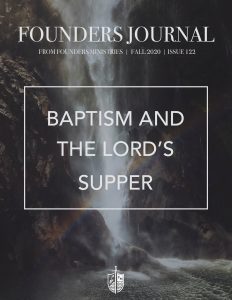Introduction
“I believe in the Holy Spirit, the holy catholic church, the communion of saints, the forgiveness of sins, the resurrection of the body, and the life everlasting. Amen.”
Affirmation after affirmation rolls off the tongue in the triumphant crescendo of syllables that concludes the Apostles’ Creed. In Protestant printings of this text, a footnote or parenthetical statement jarringly interjects to assure readers that “catholic” doesn’t actually mean “Catholic,” but in fact carries an earlier meaning of the adjective: “universal.” In light of the earnest impulse to preclude possible misunderstanding of the term “catholic,” it is interesting that the following phrase “the communion of saints” then passes without prompting a similar rush to explanation. Yet doesn’t “the communion of saints” also deserve a moment’s reflection on its meaning? What should one believe when professing this kind of conviction, and what difference does it make?
Background of “On the Communion of Saints” in the Second London Baptist Confession
The First London Baptist Confession of Faith (1644), Article 34, simply states that “all men” ought to come into the church “to have communion here with the Saints.” The confession does not further develop the concept of this communion nor specify the identity of these “saints,” other than perhaps paralleling “saints” with “believers” in Article 31.[1]
In contrast, within the Second London Baptist Confession of Faith (1689) appear the two paragraphs of Chapter 27, titled “On the Communion of Saints.”[2] The text weaves together elements from both the Westminster Confession (1647)[3] and the Savoy Declaration (1658)[4] treatments of the topic, for the most part accepting Savoy Declaration edits but retrieving from the Westminster Confession a closing defense of the concept of private property.
A literary composite, “On the Communion of Saints” in the Second London Baptist Confession of Faith adheres closely to its sources. That said, appropriation of that source material into a Baptist context frees the text from its prior denominational commitments. For Baptists, the value of the Confession’s treatment of the communion of saints lies in the degree to which it reflects the theology of the Bible.
Biblical Theology within the Chapter
Scripture passages cited in paragraph 1 include some of the biblical foundations of the doctrine of union with Christ, in that Christ is the head of his body, the church. The Spirit works upon those who are within the body, whose old selves have experienced crucifixion and are now dead. These renewed people receive Christ’s grace and experience fellowship with each other, as well as with God the Father and the Son. This fellowship among the “saints” is dynamic, involving encouragement, admonishment, and sacrifice for each other’s sake.
Paragraph 2 builds upon themes from Paragraph 1, explicitly stating what might have otherwise remained implicit. For example, the Confession first cites the exhortation in the book of Hebrews to meet together for mutual edification: a surprisingly fresh and convicting word from the Lord for the present day. This edifying relationship begins in the family and extends to the church, exemplified in Paul’s well-known “body parts” analogy in 1 Corinthians 12:14-27. As mentioned previously, it seems that the framers of the Confession felt burdened to specify that the generosity one exhibits toward others flows from retaining personal property rights rather than surrendering them to the community. Whatever prevailing conditions may have prompted emphasis on this point in 17th century England, contemporary readers would do well to remember that the question at hand was whether to hand over one’s property to the community of faith, not to civil government.
Observations on the Chapter
Regarding both paragraphs of Chapter 27 taken together, at least three observations seem appropriate. First, the Chapter is rather short. This brevity could lead to a misperception that its content is perfunctory: confessionally necessary perhaps, but not of primary concern. Yet since the Chapter clearly touches upon ecclesiology—the doctrine of the church—, lack of length need not signal insignificance. In fact, since the theological currents of our contemporary era seem to throw the nature of the church into open question, it would be especially helpful for present-day Christians to pay attention to Chapter 27.
Second, the scriptural basis of the Chapter does not directly draw from the Old Testament. In truth, limited interaction with the Old Testament is characteristic not only of the rest of the Confession but also of most Christian statements of faith. Yet since no domain of Christian thinking should suffer lack of influence from the full counsel of God, the present study aspires to thrust the roots of the Confession’s ecclesiology even deeper into biblical revelation than the Confession roots itself.
Third, the Chapter characterizes what the “communion of saints” should be like without defining either “communion” or “saints.” If all believers were to share a common understanding of these terms, such definitions would be unnecessary. However, it would be difficult to argue that agreement on the meaning of the “communion of saints” prevails even within single churches, let alone broadly among all Christians. So let’s examine what we can learn from Scripture about the “communion of saints.”
Saints
The expression “the communion of saints” does not appear in the Bible, though the main terms koinonia (fellowship, or “communion”) and hagios = (holy, or “saint” when used as a noun) each appear frequently in the New Testament.[5] Since we are interested in the “communion” that “saints” experience, it is helpful at the outset to identify these “saints.”
First, we should note that New Testament “saints” are not an especially holy caste, set apart from other believers. Instead, “saint” appears to refer to believers generally, as in Romans 1:7: “To all those in Rome who are loved by God and called to be saints: Grace to you and peace from God our Father and the Lord Jesus Christ.” “Saint” can refer to both the living and the dead. As for deceased saints, there is no support in the Bible for church traditions that following their deaths, saints begin functioning as otherworldly mediators standing between humanity and God, whose intercession adds merit to the prayers of believers who are still living.
The normal grammatical gender of “saint” in New Testament Greek is masculine, but this is a matter of grammar and not sex. Enoch exclaims in Jude 14, “Behold, the Lord comes with ten thousands of his holy ones.” Here the “holy ones” word (which is the “saints” word) is feminine, but only because “ten thousands” is without exception grammatically feminine in Biblical Greek. In the one Scripture passage in which the reader might suspect that there is a male-specific use of “saint,” Acts 9:41, the “saints” and the “widows” are indeed two distinct groups. However, this is only because these widows had been the specific group of women inside a house in verse 39, whom Peter in verse 40 then sent outside with everyone else.
At first glance it might be tempting to view the New Testament’s use of “saint” to refer to all male and female believers as a desacralization of the word, a pulling down of a lofty term to a common level, a divesting of special meaning. In other words, if everyone in the church is a “saint,” then the word seems to lose its uniqueness and become merely a synonym for a Christian brother or sister. However, Old Testament use of a related term suggests that there may actually be a theological motive behind New Testament authors choosing to call believers “saints.”
In Leviticus 11:44–45, all Israelites received the command to be holy (qadosh), because God himself is holy.[6] However, there are only three Old Testament passages that go on to use that Hebrew “holiness” term for people as a noun, two of which are in the Psalms: Psalm 16:3, “As for the saints in the land, they are the excellent ones, in whom is all my delight,” and Psalm 34:9, “Oh, fear the Lord, you his saints, for those who fear him have no lack!” Yet there seems to be a certain hesitation to apply the adjective that describes God’s very nature to his people, for other “saint” passages in the Psalms use a word communicating devotion (ḥasid) rather than holiness.
Then in the apocalyptic visions of the book of Daniel appears the only other use of qadosh as a noun for people, and that Hebrew word in Daniel 8:24 follows six rapid-fire appearances of the Aramaic cognate qadish in only five verses in Daniel 7. These “saints of the Most High shall receive the kingdom and possess the kingdom forever, forever and ever” (Daniel 7:18). Tracing this eternal kingdom backward in time, in Daniel’s vision this is the kingdom already given to the one “like a son of man” who came “with the clouds of heaven” and was presented before the Ancient of Days, seated on his heavenly throne (Daniel 7:13). Further back in the book of Daniel, Nebuchadnezzar’s post-madness confession revealed that this everlasting kingdom belongs to the Most High God (Daniel 4:3, 34).
Therefore, moving forward again through the logic of Daniel 7, the Most High God gives his kingdom to the one “like a son of man,” who receives the worship of all peoples (Daniel 7:14). Then the “saints of the Most High” receive the kingdom, apparently after an eschatological judgment (Daniel 7:27). However, this “receiving” of the kingdom is not a transfer of lordship, because the Most High still receives worship at the end of the vision. These “saints” do not somehow meld with the Most High to become one being with him (nor with the one “like a son of man”), nor do they usurp the Most High’s rule. Even so, there is some kind of significant sharing of the Most High’s kingdom, without fine delineation of everything that sharing entails.
At the time of the writing of Daniel 7, its visionary events were in the far future. However, in the Gospels, Jesus (with a roundabout, third person manner of speaking) explicitly identifies himself as the Son of Man, and furthermore as one who comes on “the clouds of heaven” in Mark 13:26 (also Matthew 24:30) and Mark 14:62 (also Matthew 26:64). Additionally, John’s vision in Revelation 1:7 more directly states that Jesus “is coming with the clouds.” From a biblical theology standpoint, the “Son of Man” in the New Testament is the one “like a son of man,” and likewise the “saints” in the New Testament correspond to the “saints” in Daniel 7.
Keeping these Old Testament theological roots in mind, it is possible that the New Testament practice of referring to all believers as “saints” conveys both present and future implications for the church. As for the present, by virtue of being categorically called holy as “saints,” through Christ, believers are holy in a way that ancient Israel was not. As for the future, the “saints” as God’s holy people will indeed inherit the kingdom of God. In tension with this blessed hope, then, are the New Testament’s warnings about those who will not in fact inherit the kingdom of God (1 Corinthians 6:9–10, 15:50; Galatians 5:19–21). Simply put, they are not among the saints.
Communion
Koinonia refers to an exceedingly close relationship characterized by action in a spirit of unity, frequently entailing partnership in activities and mutual sharing. This strong mutuality of koinonia clarifies the interpretation of Philemon 6, which the ESV renders “And I pray that the sharing of your faith may become effective for the full knowledge of every good thing that is in us for the sake of Christ.” Contrary to the plain English reading of the sentence, Paul does not express a general wish that Philemon’s evangelistic efforts (Philemon’s “sharing” of his faith) may become more effective. Instead, the “sharing” here is koinonia. Paul prays that Philemon will actively live out his faith in tight connection with Paul and other Christians. This “sharing” fellowship newly includes the runaway slave Onesimus, whom Paul calls a “beloved brother” in Philemon 16. No wonder that the former master and slave relationship had to change drastically, for Philemon and Onesimus should henceforth live in koinonia!
Interestingly, while mental images that spring from the English word “fellowship” typically consist of people warmly interacting with each other in the same place, the bond of believers in the physically dispersed body of Christ could generate significant acts of partnership and sharing across long distances. For example, Romans 15:26 mentions that believers in Macedonia and Achaia “have been pleased to make some contribution for the poor among the saints at Jerusalem,” in which the “contribution” is itself koinonia.[7] Among the members of these churches in Greece there need not have been a single personal connection to Jerusalem, but they were in fellowship with the church in Jerusalem nonetheless.
Koinonia was such a lived reality for the early church that New Testament authors freely used this term to describe believers’ relationship with God. Christians enjoyed koinonia with God (1 John 1:6), the Father and the Son (1 John 1:3), the Son (1 Corinthians 1:9, 10:16; Philippians 3:10), and the Spirit (2 Corinthians 13:14, Philippians 2:1). If believers experience such comprehensive fellowship with every member of the triune Godhead and with each other, it is little wonder that Paul would express thankfulness for “koinonia in the gospel” with fellow believers (Philippians 1:5).
With this biblical sense of the deep mutual interconnectedness of koinonia in mind, it is understandable that the framers of the Second London Baptist Confession would want to affirm in paragraph 1 that union with Christ does not entail merging with him into a shared state of personhood, which would unavoidably entail believers’ participation in deity along with Christ the God-man. This same distinction between the “saints” and God pertains in Daniel 7, although describing the God-human relationship with the special term koinonia would need to wait for New Testament revelation.
The Communion of Saints for Today
The “communion of saints” is a doctrine in need of recovery in the contemporary church. In Western cultural settings, the church must continually contend with fragmentation incited by exaggerated individualism. Rugged individualists have little interest in continual engagement with other saints to “promote their mutual good” by extending their sharing “to the whole household of faith” (using terms from the Confession). After all, the depth of relationship entailed by the communion of saints is uncomfortably demanding of time and other resources. As for discomfort, the isolated saint may simply think it unreasonable to try to have communion with some other saint when he or she doesn’t even like that person.
Unfortunately, recovery of the “communion of saints” in the contemporary church requires more than a cultural shift among the saints in general. The leadership and management structure of most churches itself resists the full engagement of every church member in the life of Christ’s body. Generally speaking, ministers do ministry, and congregants receive ministry, whatever system of church polity is in place. If congregations were to shift toward a more active posture of ministry engagement for all without changing expectations of what leaders do accordingly, the leaders would rapidly burn themselves out in the attempt to lead in the same programmatic ways they had before.
In addition, a relatively new enemy of the communion of saints is many churches’ passivity or even abandonment of ministry in an age of virtualization. The model of “body life” encapsulated in the concept of the communion of saints requires a high degree of investment of one’s self in others as a gathered, functioning community. Real fellowship entails sacrifice, relational vulnerability, and thus toleration and management of risk. Regrettably, many churches essentially decline to take risks of any kind, and their primary “ministry” has become narrating briefing slides to miniature, grainy images of half-dressed saints against virtual backgrounds. At best, whatever unfolds on the screen before them commands a fraction of their attention as they crouch over electronic devices in isolation.
All told, the lack of spiritual vitality in many contemporary churches is depressingly palpable. Turning around this lamentable situation is certainly not a matter of simply placing greater emphasis on certain theological themes, even the often professed but increasingly seldom believed doctrine of the “communion of saints.” In contrast, what the church needs to do is to repent and believe the gospel. This is because the gospel brings about not a mere change of attitude, but a re-creation, a new creation.
In the new covenant community, all of the redeemed are saints, and all receive the commission to serve. Obedience to Jesus’s commands takes place most naturally through full participation in the body of Christ and the sharing of its burdens, not merely knowing the “right answers” to theological questions. Indeed, “If we say we have fellowship with him (God) while we walk in darkness, we lie and do not practice the truth. But if we walk in the light, as he is in the light, we have fellowship with one another, and the blood of Jesus his Son cleanses us from all sin.” (1 John 1:6–7) May the contemporary church rediscover the thoroughgoing communion that saints are to enjoy with each other and with God, and may the resulting revolution of sacred love within the body of Christ fuel the revival we pray that the Spirit would begin in us.
[1] W. J. McGlothlin, Baptist Confessions of Faith (Philadelphia: American Baptist Publication Society, 1911), 183–184.
[2] Ibid., 268–269.
[3] Philip Schaff, The Creeds of Christendom, with a History and Critical Notes, Vol. 3: The Evangelical Protestant Creeds, with Translations, 4th rev. ed. (New York: Harper & Brothers, 1919), 659–660.
[4] Williston Walker, The Creeds and Platforms of Congregationalism (New York: Charles Scribner’s Sons, 1893), 396–397.
[5] The only biblical passage in which these two words appear close together is the final verse of 2 Corinthians as Paul writes “may . . . the fellowship of the Holy Spirit be with you all.”
[6] Peter later cites this passage and applies the same logic to Christians in 1 Peter 1:14–16; their conduct should reflect God’s holiness.
[7] See the similar use of koinonia in the sense of “contribution” in 2 Corinthians 8:4 and 9:13.























